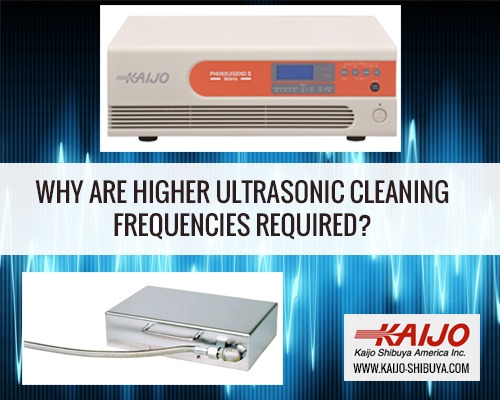Why Are Higher Ultrasonic Cleaning Frequencies Required?
May 10, 2019
 Ultrasonic cleaners quickly remove contamination from part surfaces, but using the right frequency is important. If the ultrasonic frequency of the cleaning system is too high, cleaning could be less effective and take longer. If it is too low, delicate parts could be damaged. Ultrasonic cleaning systems are extremely versatile and can excel at most cleaning applications, but only if the operating frequency matches the tasks to be performed.
Ultrasonic cleaners quickly remove contamination from part surfaces, but using the right frequency is important. If the ultrasonic frequency of the cleaning system is too high, cleaning could be less effective and take longer. If it is too low, delicate parts could be damaged. Ultrasonic cleaning systems are extremely versatile and can excel at most cleaning applications, but only if the operating frequency matches the tasks to be performed.
How the Ultrasonic Frequency Affects the Cleaning Function
Ultrasonic cleaning systems generate a high-frequency electric signal that is converted into sound waves by an ultrasonic transducer. The transducer is immersed in the cleaning solution and produces sound waves in the liquid. Microscopic cavitation bubbles form in the low-pressure troughs of the waves, and the bubbles collapse in the high-pressure peaks.
The collapse of the bubbles creates a tiny suction in the cleaning liquid and a tiny high-pressure jet emerges from the collapsed bubble. The collapsing bubbles are responsible for the cleaning action of the ultrasonic system.
Low frequencies have longer cycle times and the wave troughs are wider resulting in larger bubbles. High frequencies have smaller bubbles because there is less time for the bubbles to grow in the comparatively narrow troughs. The size of the bubbles determines how much energy is liberated when they collapse, and it corresponds to the intensity of the cleaning action.
How Ultrasonic Systems Remove Dirt and Particles
The cavitation bubbles produced by the ultrasonic cleaning system appear wherever the cleaning solution can penetrate. The bubbles can clean inside hollow tubes, in the threads of bolt holes, inside dead-end holes, and in cracks. The bubbles are formed with an even distribution, and cleaning is uniform everywhere.
The collapse of cavitation bubbles on the surface of the part to be cleaned produces two types of cleaning action. The suction effect from the implosion of a bubble removes loose dirt particles from the contaminated surface. The tiny jet resulting from the collapse of the bubble hits the surface and loosens more dirt. This combined cleaning action is so powerful that most surfaces are completely clean within minutes.
Ultrasonic Cleaning Works Differently with Different Materials
While the cleaning action of ultrasonic systems is always the same, the effects on the materials to be cleaned can differ. Heavy contamination with carbon deposits or tough grease requires the high energy bubbles of low-frequency systems, but these bubbles could also remove some of the underlying material. That’s why choosing the right frequency is important.
Typical candidates for low-frequency cleaning include automotive parts such as cylinder valves and carburetors. The deposits to be removed are often stubborn and hard to clean, while the steel of the underlying material has a hard surface that the bubbles can’t damage.
Even with automotive parts or similar metal components, sometimes the metal undergoes a surface treatment that softens the top layers. In such cases the system frequency has to be increased to make the cleaning action less aggressive. To compensate and maintain a short cleaning time, the cleaning solution can be heated to soften deposits and make them easier to remove.
Delicate parts need a high frequency ultrasonic cleaner to avoid damage to their surfaces or delicate physical structure. Parts such as medical instruments, semiconductor components and computer parts often have soft surfaces or structures that require gentle cleaning. The ultrasonic frequency choice has to balance the reduced cleaning power, the fragility of the parts and the type of contamination to achieve optimal cleaning performance.
Kaijo Can Help with System Selection
Kaijo has extensive experience in the field of ultrasonic cleaning and offers free consulting to help analyze each customer’s application and recommend the best system. The Phenix Legend II high-frequency ultrasonic cleaner is specifically designed for delicate cleaning jobs. Cleaners with other frequencies and features are also available from the company’s complete line of industrial ultrasonic cleaning equipment.





